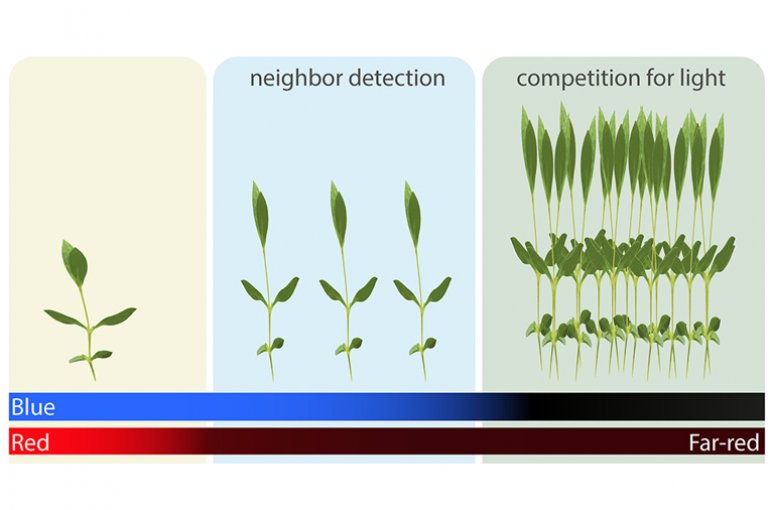Plant makes growth spurt as competition approaches
Publication in Current Biology

Plants know when to grow faster to stay ahead of the competition based on the colour of the light that reaches them. This process works even when the competition is still far away. But the plants work even harder as the danger approaches. Biologists at Utrecht University have discovered that blue light is essential to this process. They published a description of the exact mechanism in the 23 November issue of Current Biology.
Even before a neighbour's shadow reaches a plant, it knows that a competitor is near. That is because plants have light sensors, called phytochromes, that are sensitive to the ratio of red light to far-red light. If the plant senses more far-red light (a colour that is invisible to humans) than red light, due to far-red reflection by nearby plants, then the plant prepares for competition. Their stems grow longer and thinner, and their leaves reach higher. That way, they can prepare for the future and try to attain a better position among the surrounding vegetation.
Acute problem
Remarkably, plants grow even faster once the competitor approaches and the problem becomes more acute. Until know, scientists had not observed that phenomenon. “There must be another light signal involved,” posited Professor of Plant Photobiology Ronald Pierik, who led the study. He therefore examined the function of the receptor that is sensitive to blue light, called cryptochrome. Like phytochrome, this receptor controls proteins involved in plant growth.
Fine-tuning
Astonishingly, the researchers in Utrecht discovered that a protein that actually inhibits growth plays a crucial role in this process. Under the influence of a low ratio of red to far-red light, more of this protein is present, in addition to a range of proteins that enhance plant growth. “Apparently, this protein is necessary for fine-tuning”, says Pierik. “It’s like a knob that precisely regulates the amount of growth that is needed.”
Efficient growth
The researchers observed that when the amount of blue light decreases, the amount of this protein in the plant decreases dramatically, and the plant begins to grow faster. This simulation with low levels of blue light and a low ratio of red to far-red light seems to closely resemble the light composition experienced by plants in thick vegetation. Pierik: “Now that we have uncovered these mechanisms, we can focus more on guiding these kinds of reactions in crops, in order to achieve more efficient growth.”
Publication
Mieke de Wit, Diederik H. Keuskamp, Franca J. Bongers, Patricia Hornitschek, Charlotte M.M. Gommers, Emilie Reinen, Carmen Martínez-Cerón, Christian Fankhauser & Ronald Pierik.
Integration of phytochrome and cryptochrome signals determines plant growth during competition for light
Current Biology, 23 November 2016

